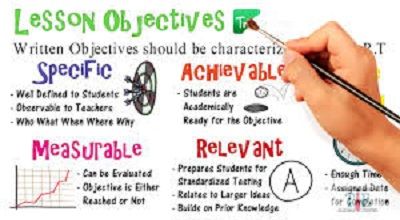Setting Objectives In A Lesson Plan
When setting objectives in a lesson plan, it’s essential to keep in mind the learning outcomes you want your students to achieve. Objectives should be clear, specific, and measurable to ensure that students understand. What they will learn and how they will be assessed. Here are some steps to follow when setting objectives in a lesson plan:
- Start with the learning outcome: Begin by identifying the overarching goal of the lesson. What do you want your students to be able to do or know by the end of the lesson? This could be a specific skill, knowledge, or understanding.
- Break it down: Once you have identified the overall learning outcome, break it down into smaller, more manageable objectives. These objectives should be specific and measurable, and relate directly to the learning outcome.
- Use action verbs: When writing objectives, use action verbs that describe what the students will be able to do or demonstrate. For example, “identify,” “analyze,” “evaluate,” or “create.”
- Be realistic: Ensure that your objectives are realistic and achievable within the time frame of the lesson. If the objectives are too ambitious, students may feel overwhelmed and frustrated.
- Align with assessments: Ensure that the objectives are aligned with the assessments. That will be used to measure student learning. This will help you determine whether the objectives have been met. And how well students have learned.
Overall, setting clear and specific objectives in a lesson plan is essential for guiding student learning and ensuring that they are able to achieve the desired outcomes.
Benefits Of Objectives
Setting clear objectives is essential for effective teaching and learning. Here are some of the benefits of having clear objectives in a lesson:
- Focus: Objectives help to keep the lesson focused on the desired learning outcomes. By having clear objectives, the teacher can ensure that. The lesson is on track and students are not distracted by irrelevant topics.
- Motivation: Objectives can help to motivate students by giving them a clear understanding of what they will be learning and why it is important. When students understand the purpose of the lesson and what they are expected to achieve. They are more likely to engage with the material and take an active role in their learning.
- Assessment: Objectives provide a clear basis for assessment. By setting measurable objectives, the teacher can assess whether or not students have achieved the desired learning outcomes. This can be used to inform future teaching and to identify areas where students may need additional support.
- Differentiation: Objectives can be used to differentiate instruction. By setting different objectives for different students. The teacher can ensure that each student is working at their own level. And that they are being challenged appropriately.
- Communication: Objectives can be used to communicate with parents and other stakeholders. By sharing the objectives of a lesson, parents can understand what their child is learning and how they can support their learning at home.
Overall, clear and measurable objectives are essential for effective teaching and learning. They provide a roadmap for the lesson, motivate students, provide a basis for assessment, and allow for differentiation and effective communication with stakeholders.
Features Of Objectives In Lesson Plan
Objectives in a lesson plan should have certain features to be effective in guiding student learning. Here are some of the key features that objectives should have:
- Clear and specific: Objectives should be clear and specific. So students know exactly what they are expected to achieve. Vague objectives can lead to confusion and misunderstandings.
- Measurable: Objectives should be measurable so that students can demonstrate what they have learned. This allows for the assessment of learning outcomes and helps to track progress.
- Realistic and achievable: Objectives should be realistic and achievable within the timeframe of the lesson. Objectives that are too ambitious or unrealistic can lead to frustration and disengagement among students.
- Aligned with standards: Objectives should be aligned with standards. Such as learning outcomes. Or curriculum frameworks. This ensures that the lesson is meeting the learning objectives and that students are learning. What they are supposed to be learning.
- Action-oriented: Objectives should use action-oriented verbs that describe what students will be able to do or demonstrate. For example, “identify,” “analyze,” “synthesize,” or “create.”
- Relevant: Objectives should be relevant to the lesson and should connect to previous learning or real-world contexts. This helps students understand the importance of what they are learning and how it relates to their lives.
- Flexible: Objectives should be flexible enough to accommodate different learning styles and abilities. This can involve providing options for students to demonstrate their learning or offering different levels of complexity.
Overall, objectives in a lesson plan should be clear, measurable, realistic, aligned with standards, action-oriented, relevant, and flexible. These features ensure that the objectives are effective in guiding student learning and helping students achieve the desired learning outcomes.
In Summary
In summary, objectives in a lesson plan should have certain features to be effective in guiding student learning. They should be clear, specific, measurable, realistic, achievable, aligned with standards, action-oriented, relevant, and flexible. Clear objectives help to keep the lesson focused on the desired learning outcomes, motivate students, provide a basis for assessment, allow for differentiation and effective communication with stakeholders, and help students understand the importance of what they are learning and how it relates to their lives. By following these features when setting objectives in a lesson plan, teachers can ensure that the objectives are effective in guiding student learning and helping students achieve the desired learning outcomes.
